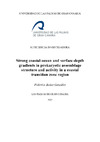Please use this identifier to cite or link to this item:
https://accedacris.ulpgc.es/jspui/handle/10553/3496
| Title: | Strong coastal-ocean and surface-depth gradients in prokaryotic assemblage structure and activity in a coastal transition zone region | Authors: | Baltar González, Federico | Director: | Aristegui, J. Gasol, Josep M. Herndl, Gerhard J. |
UNESCO Clasification: | 2510 Oceanografía | Keywords: | Procariotas Bacterias marinas Plancton |
Issue Date: | 2007 | Abstract: | The distribution of Crenarchaeota, Euryarchaeota and some major groups of Bacteria (SAR 11, Roseobacter, Gamma-proteobacteria and Bacteroidetes) was investigated in the North Atlantic water column (surface-2000 m) along a transect from the coastal waters of the NW Africa upwelling to the offshore waters of the Canary Coastal Transition Zone(CTZ). Catalyzed reported deposition fluorescence in situ hybridization (CARD-FISH) was used to describe the composition of the prokaryotic assemblages. Additionally bulk picoplankton abundance and leucine incorporation was determined Pronounced changes in the composition of the prokaryotic assemblages were observed from the coastal region to the open ocean and at the Deep Chlorophyll Maximum (DCM) accompanied with decreasing bulk heterotrophic activity. All bacterial groups decreased in absolute abundances from the coast to the open ocean, whereas both archaeal groups increased towards the open ocean. SAR 11, was the most abundant prokaryotic group in the DCM and probably responsible of major changes in bulk heterotrophic production. Prokaryotic abundance and activity decreased two and three orders of magnitude, respectively, fromthe surface to 2000 m depth. Prokaryotic growth rates were, however, high in the mesopelagic zone (about 0.13 d-1), compared to other reports from the central North Atlantic. Throughout the water column, the contribution of SAR11 to total picoplanktonabundance decreased from 42% in the DCM to 4% at 2000 m depth, while Crenarchaeota increased from 1% in the DCM to 39% in the Oxygen Minimum (OM) layer. A clear influence of the different intermediate water masses was observed on the bulk picoplankton heterotrophic activity with lower leucine incorporation rates corresponding to layers where patches of Antarctic Intermediate Water were detected. Our results show that coastal-ocean and surface-depth gradients in bulk prokaryotic abundance and production,as well as in assemblage composition, were comparable to changes observed in basin-scale studies, pointing the coastal transition zones as regions of strong variability in microbial diversity and metabolism. | Description: | Programa de Doctorado: Oceanografía | Faculty: | Facultad de Ciencias del Mar | URI: | https://accedacris.ulpgc.es/handle/10553/3496 |
| Appears in Collections: | Trabajo final de máster |
En el caso de que no encuentre el documento puede ser debido a que el centro o las/os autoras/es no autorizan su publicación. Si tiene verdadero interés en el contenido del mismo, puede dirigirse al director/a o directores/as del trabajo cuyos datos encontrará más arriba.
Show full item recordPage view(s)
64
checked on Apr 13, 2024
Download(s)
75
checked on Apr 13, 2024
Google ScholarTM
Check
Share
Export metadata
Items in accedaCRIS are protected by copyright, with all rights reserved, unless otherwise indicated.
